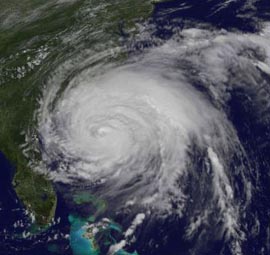
Hurricane Damage – The first 60 Days of the Long Road Back [Download Printable PDF here ]
Hurricanes have become a big part of the end of summer ritual for people living in the southeast with massive economic impact. These costs are counted in the billions of dollars and are felt by industry, federal and state governments, businesses, and homeowners. For example, the City of New Orleans has in place a 7 million dollar contract to bus the residents of the Big Easy out of the city at the right time before the loss. The economic impact of Katrina is in excess of 100 Billion dollars.
According to global weather studies, we are in an era where more rather than less of these events should be expected. The purpose of this report is to identify some of the sticking points in these claims process based on my 22 years of working in the insurance restoration industry both as a contractor and also as an expert/appraiser for insurers and owners.
Hurricane Damage: Documentation
After the loss and the initial safety concerns are addressed, an immediate plan for the mitigation of the loss and the documentation of the conditions is first and foremost. I suggest before the first tree is cut off the building or the first temp roof applied that the property is photographed in full. It is not unwise at this time to frame your photo within the neighborhood to establish that surrounding properties are also equally affected. It is important to include landmarks in your photo and then pictures with perspective and then up close with a date stamp.
The pictures should include the flood line with a tape measure from the finished floor elevation if one exists, and any objects that impacted the structure or remain on the building prior to removal if possible. If these photos can be digital, the ability to share them with insurers and others is greatly increased. Never give to any person your original pictures. In addition, it is imperative to have pre-storm pictures of the contents and building prior to the loss in order to document the conditions at your property especially in the case of a total loss or complete loss of the structure as was all too common after Hurricane Katrina hit the Gulf Coast in 2005.
Hurricane Damage: Mitigation
The second step is to mitigate the damages as required in most insurance policies. After a major hurricane, it may be some time before you will get the pleasure of a visit from your insurer. It is up to you to have the financial ability to mitigate the loss or to keep it from becoming worse if possible. The blue roof program from FEMA is an excellent method and at no cost for the individual for complying with this requirement. In addition, to eliminating the water from further entering the property a plan to remove water-damaged building components should be implemented.
As many people are aware mold is not good for people to breathe and can be toxic to certain people. According to research from many sources, mold can begin in 24–48 hours after the introduction of water to cellulose building components ie: drywall, interior wood trim, wallpaper, etc. (EPA Mold Guide) Often times people have not even returned to their properties in this amount of time especially on the barrier islands. Many of the insurance policies out there specifically exclude the costs associated with detailed mold remediation work. Therefore it is advantageous to remove water-damaged building components before they can get worse and treat the areas affected with a mildewcide to prevent further spread of this condition.
Hurricane Damage: Causation, Quantification and Costs
The next step in the restoration of a property affected by an insured loss is to establish how the damage occurred, what was the result to the structure from sometimes more than one peril and what will it cost to restore. This is where the business of restoration gets very complicated and in some cases a person may wish to consult with an expert in these affairs. In the case of wind vs. flood, there are many more factors that they could not be enumerated in this report but it is critical to come up with an understandable chain of logical conclusions.
Look at the flood line, the impact of objects carried in the flood either still or velocity water, the elevation of the property, the wind speeds and the presence or absence of straight line or tornado winds and compare them to the structure and its attributes.
Once an opinion is reached as to how the damage occurred then break out the loss according to the peril and the actual size and type of building materials affected. Find your house plans and have a takeoff created by either yourself or hire a professional. This should include the stated value affected of each of the items delineated by cause. The roof may be 9000 s.f. of EPDM with 1.5 inches of ISO insulation below or the flood may have taken the bottom four feet of drywall on the bottom floor.
In action…
Having a trusted contractor, engineer, architect, appraiser or expert available to break out and put costs to this data will greatly enhance your ability to have an apples to apples comparison with the numbers established by the adjuster. There are many programs that specialize in this type of cost estimating and we prefer Xactimate after using it for more than a decade. These programs compile costs for individual areas and provide them to insurance professionals and restorers and are based online by line details of the damage. Persons unfamiliar with the process can find these programs to be daunting if they do not expect this level of detail.
In addition to the direct physical damages and costs, there may be requirements associated with law and ordinance for particular areas in specific with flood and wind speed zones. If you live in flood zone do not be surprised to learn that your property may be required to be elevated after a loss especially those over 50 % of the value of the structure (pre-storm). In some cases this is not practical and relegates the property to a that of a total loss requiring demolition and reconstruction compliant. I recommend a visit to your county building department and the local flood plain administrator for any person caught in these close details.
Important Links:
*This should not be substituted for professional legal advice, consult with your lawyer for legal advice and Ask your insurance professional to discuss the details of your policy and insurance needs.
**Satellite image of Tropical systems courtesy of NOAA and the National Hurricane Center
